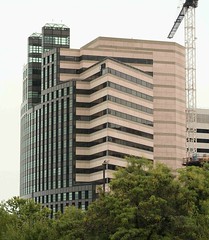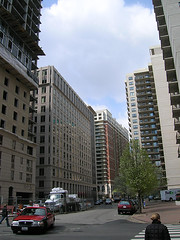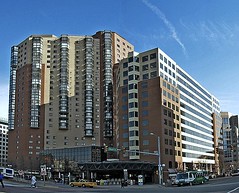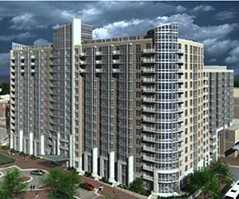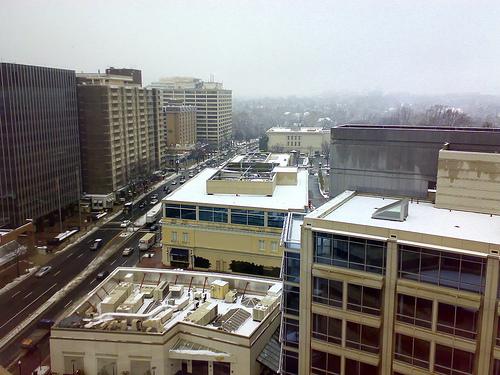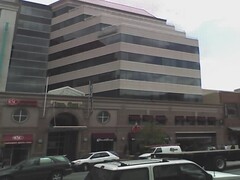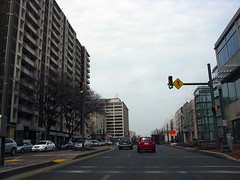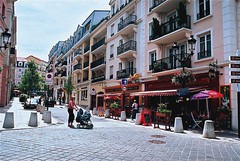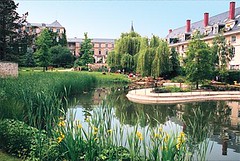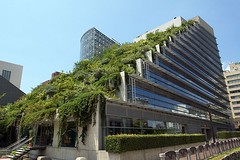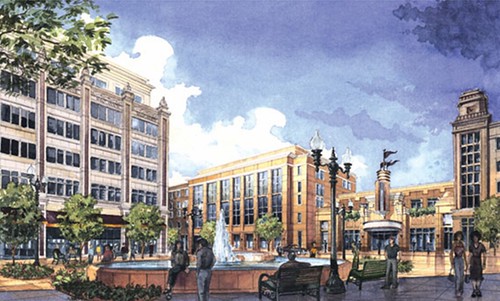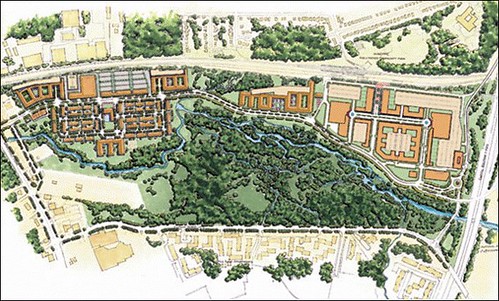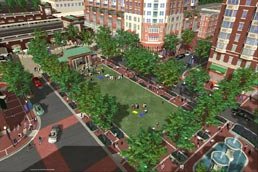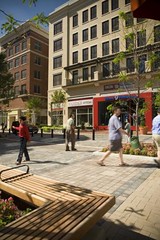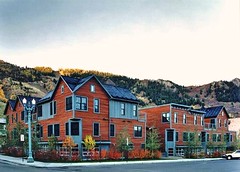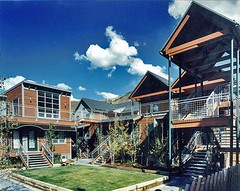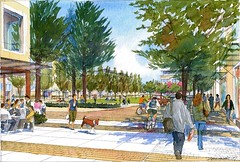Smart growth must become more demanding, more community-oriented, and greener (literally)

Posted August 18, 2009 at 1:31PM
Is it any wonder that neighbors continue to oppose density (oops, I meant "compact development") when this is what we have been giving them? We smart growth advocates have gotten lazy. The issue has evolved in the last decade but, for the most part, we haven't. We're stuck in a mindset from the 1990s when it was such a monumental achievement to get density built near transit that we were happy even when it was mediocre density. Unfortunately, more often than not, that's what we've been getting.
(Warning: This is a long one, a bit of an essay. But, hey, at least it has great photos to pique your interest.)
Times have changed
Things are different now. There are still too many places where we face monumental challenges (I'm not that naïve). But, by and large, jurisdictions across the country get it today. It seems like almost everywhere, at least the planners are pushing for more urbanism, particularly around transit. It's happening all over DC, where I live. My goodness, it's happening even in places like Charlotte, Nashville, and Dallas. If that doesn't convince you that the dynamics have changed, I don't know what will.
We haven't been as successful in persuading jurisdictions to take a firm stand against suburban sprawl, but to an extent the market is coming around on that one. Sprawl is being devalued in the marketplace; demographics (watch for another post on that topic soon) and energy prices point in the direction of stronger demand for urban environments; central cities are growing again. We've made tremendous progress.
But, my god, is this the best we can do? Look at some examples of what is being built and has been built recently around Metro stations in DC's suburbs (mostly; one is in the city) in the name of transit-oriented development:
Any one of these buildings might be fine, depending on your taste. I don't have anything against high-rises per se, in the right contexts. But taken together, these examples represent a sameness and sterility - always emphasizing building mass over architectural variety and community amenities - that, in my opinion, is soul-deadening.
Why my neighbors oppose density
I live in a city neighborhood called Tenleytown. It is slowly picking up in residential density and commercial building activity along our main commercial street, Wisconsin Avenue. But in planning circles the neighborhood is best known for having defeated a modest and very reasonable proposal to build a condo building (reproposed even more modestly as townhouses, but again defeated) a short block from our Metro stop. I am convinced that a big part of the reason is that Tenleytown residents don't want our neighborhood to become another Friendship Heights, the area around the next Metro stop to the north on the Red Line:
Do you blame them? I don't. One of the most infuriating aspects of Friendship Heights, which has experienced a huge building boom in the last decade, is that the public has gotten zero green space out of the deal. None. Friendship Heights has great high-end shopping, and of course great transit access, but little else to recommend it in the way of public amenities.
There is also precious little if any meaningful green space in the concrete canyons around the Ballston or Rosslyn Metro stops in Arlington, Virginia (pictured in the first set of photos), even though both areas have exploded with new building space. The development around Arlington's Orange Line Metro stations - these two and four others - has produced great transportation performance, which I have applauded, but comparatively little to be proud of as a matter of community or design in most (not all) instances. In fact, the best thing to be said about the design of the new development is not what it has done but what it has not done: it has stayed away from nearby older, single-family neighborhoods.
As eager as I am to see long-overdue remakes of the areas around the new Tysons Corner (VA) stations and the existing New Carrollton (MD) station, I fear that we're basically going to get more of the same.
The right kind of density
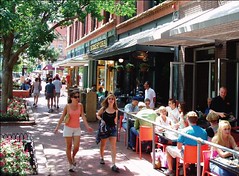 We in the smart growth movement need to become much more discriminating in what we support and what we don't. In particular, we must stop applauding density per se and start advocating what my friend David Crossley, president and founder of the great organization Houston Tomorrow, calls the right kind of density - a built landscape that respects and improves upon its neighborhood instead of overpowering it.
We in the smart growth movement need to become much more discriminating in what we support and what we don't. In particular, we must stop applauding density per se and start advocating what my friend David Crossley, president and founder of the great organization Houston Tomorrow, calls the right kind of density - a built landscape that respects and improves upon its neighborhood instead of overpowering it.
Neal Payton agrees. Payton is managing principal at the west coast office of the architecture and planning firm Torti Gallas & Partners. Writing in Urban LAndscape, he explains:
"It is safe to say that all but the most skeptical would consider a commitment to Transit Oriented Development, characterized by equal parts Density, Diversity and Design, to be part of a bold vision for a sustainable Los Angeles. I would argue that TOD should not be the end in itself, but a means to an end. Imagine great public spaces where opportunities to sustain public life become numerous. Then focus on great sidewalks, an integral part of great streets, which in turn are the major constituent of public space. As the most intimate of public spaces inhabited by individuals, sidewalks are where we have our most visceral experiences of the city. TOD represents not only an opportunity to put density near transit, but possibly as importantly, to remake the public realm creating a city of great streets and great sidewalks.
"Yet, many of us in the area have repeatedly been thwarted in our attempts to build in such a manner due to existing zoning regulations, bureaucratic inertia, and well-organized groups of NIMBYs masquerading as environmentalists. Why? Perhaps the answer lies in our focus on the first of those ingredients-density. Too little time is spent on considering and promoting the other two-diversity and design. While many of the NIMBYs can never be won over, others are merely worried that the scale of new development will overwhelm them and diminish the quality of the public realm. Frankly, who can blame them?
"'High-Density' development too often appears monolithic, insular and just plain in-human. Separated from its context so completely, it often appears to have dropped from the sky."
Payton goes on to argue for building a rich pedestrian experience and "a robust mix of uses and price points." Perhaps most important, he eschews a building-by-building approach to design in favor of a neighborhood approach that produces a varied streetscape and landscape.
I think we should be satisfied with no less, and we should speak out when development proposals deliver less. In fact, I would go further and argue that we should also insist on affordable housing, green building, green infrastructure, and useable public park space as part of any large-scale development.
"With greater density comes greater responsibility"
The same conversation, by the way, is going on in Vancouver, which is undergoing deliberate densification. In an article titled "Can Eco-density be beautiful?"  Adele Weder reports an overheard whisper at a recent public hearing: "There's no doubt about it: Eco-density architecture can be as shitty as any other kind."
Adele Weder reports an overheard whisper at a recent public hearing: "There's no doubt about it: Eco-density architecture can be as shitty as any other kind."
Vancouver's chief planner Brent Toderian admonishes us all: "With greater density," Toderian says, "comes greater responsibility." To which I say, "amen."
We also should insist that not all new development be large-scale. We don't need high density everywhere, though it is appropriate in some places, especially downtowns. But in many others, moderate density would be an awesome upgrade for the environment and much more respectful of the existing community. Remember that transportation research shows that we get the largest improvements in reducing per capita driving and emissions as we move from low density to moderate density, and much less improvement as we move from moderate to high.
Mediocrity needn't be a social imperative
Compare the dreary developments at the top of this post with some much more interesting and inviting examples (some of which are quite high density) from other parts of the world, below. After I present them I'll tell you a little about them.
The top two are of award-winning new development in Plessis-Robinson, a suburb southwest of Paris. In the middle are two views of the striking, green-terraced AROSCO building in Fukuoka, Japan, and its related public park (foreground, left). In the bottom row are redevelopment of the Neumarkt area of Dresden, Germany and the modern Sony Center in downtown Berlin. Collectively, these developments are varied in design but, in the case of Plessis-Robinson and the Neumarkt, immensely respectful to the character of the surrounding community. That was less of an issue for the Sony Center and the AROSCO building, both built in downtown environments, but it's notable that both are green buildings with compelling contemporary architecture. Every one of these examples gives back to its community in the form of great public space.
Now, we have great examples in this country, too, many of which I feature regularly in this blog. Let's start with another project at a DC-area Metro station:
In contrast to the mediocre-at-best stuff around transit stations that I showed you earlier, the much more human-scaled and amenity-rich design for new development near the Greenbelt (MD) Metro (just above) looks fabulous. It has plenty of density, too: it incorporates 1.2 million square feet of shopping, a million square feet of office space, and a thousand residences, along with a substantial park area and preserved wetlands.
Here are more examples of density done right:
I've written before about the LEED-ND-certified TOD under way for the Twinbrook Metro station in Rockville, Maryland, and nearby Rockville Town Square, shown in the first row of this set.
I bet few of you would guess, though, that Benedict Commons, the rust/wood-colored, already-built complex in Aspen featured in the middle row, has a density of 78 dwelling units per acre. High density doesn't have to mean mediocre. Although a unified complex of multi-family dwellings, the Commons is designed with varied facades to create an illusion of several single family homes and fit seamlessly into its neighborhood. All of its units are priced as affordable workforce housing, too.
The last row shows two more developments that I have featured before, both of which create outstanding community-oriented environments along with outstanding green building characteristics. On the left is the high-density, transit-oriented Station Park Green in San Mateo, California; on the right is the moderate-density Glenwood Park in Atlanta.
Raising the bar
These examples raise the bar, and it is time that we do the same. The smart growth community should not cede leadership on its signature issue to innovators in the private sector. Why in the world should we settle for the same old massive boxes that we got in the 1980s and the 1990s when it is now the twenty-first century?


